View in other NatureServe Network Field Guides
NatureServe
Montana
Utah
Wyoming
Idaho
Wisconsin
British Columbia
South Carolina
Yukon
California
New York
Cudweed Grasshopper - Hypochlora alba
Other Names:
Sage Grasshopper
General Description
The following is taken from Capinera and Sechrist (1982),Capinera et al. (2004), Pfadt (2002), Scott (2010), Vickery and Kevan (1985).This is a small to medium sized grasshopper. It is pale, grayish green, with short-wings. Under magnification, the body can be seen to be speckled with brown spots. A broad green band extends from behind the eye onto the lateral lobe of the pronotum and the sides of the meso and metanotum (thorax). In overall color, it matches its host plant where it usually rests.
Phenology
Overwinters in the egg stage and is a seasonally late-developing grasshopper. Eggs hatch and nymphs begin to appear in early June. Adults are present from July to October, but most abundant in July and August (Capinera and Sechrist 1982, Capinera et al. 2004, Pfadt 2002, Scott 2010).
Diagnostic Characteristics
Body size for males 15-17mm, females 17-22 mm. The forewings (tegmina) are short and pointed, but long winged individuals have been reported in females. The wings are a uniform green. Hind tibiae are blue green. The pronotum is slightly wider posteriorly (Capinera and Sechrist 1982, Capinera et al. 2004, Pfadt 2002, Scott 2010, and Vickery and Kevan 1985).
Could be confused with a slantfaced grasshopper, Gomphocerinae, due to the front angle of its head, but the diagnostic ventral spur between the front legs will indicate otherwise (Scott 2010).
Species Range
Montana Range
Range Descriptions
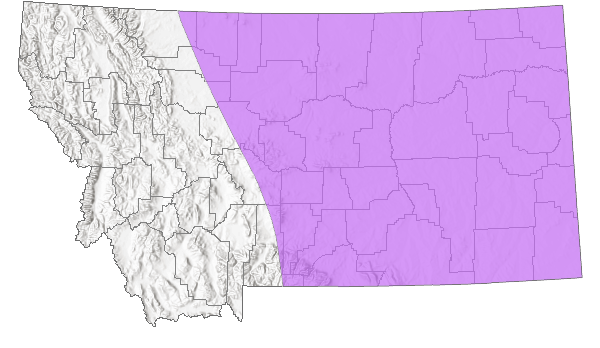
 Native
Native
Range Comments
The following comes from Capinera et al. (2004), Scott (2010), and Pfadt (2002). This is a Great Plains species, inhabiting grasslands east of the Rocky Mountain front. It occurs from southern Saskatchewan and Manitoba, Canada to northern Texas, eastward to western Iowa. In Montana, it ranges over almost two-thirds of the eastern portion of the state with confirmed reports in 22 counties.
Observations in Montana Natural Heritage Program Database
Number of Observations: 6
(Click on the following maps and charts to see full sized version)
Map Help and Descriptions
Relative Density
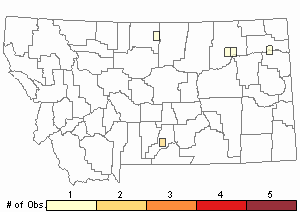
Recency
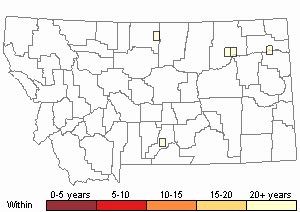
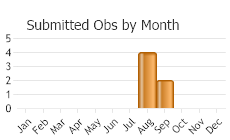
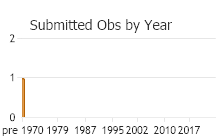 (Observations spanning multiple months or years are excluded from time charts)
(Observations spanning multiple months or years are excluded from time charts)
Habitat
It has an irregular distribution due to its dependence upon habitats where
white sagebrush (
Artemisia ludoviciana) and
rubber rabbitbrush (
Ericameria nauseosa) occurs (Capinera and Sechrist 1982, Pfadt 2002, Vickery and Kevan 1985).
Food Habits
The Cudweed Grasshopper is considered monophagous, as it feeds almost exclusively on
white sagebrush. It does eat other species in the genus
Artemisia as well as trace amounts of various grasses and forbs. It is the only species of grasshopper able to survive on
white sagebrush exclusively (Capinera and Sechrist 1982, Capinera et al. 2004, Pfadt 2002).
Reproductive Characteristics
The following is taken from Capinera et al. (2004), Capinera and Sechrist (1982), and Pfadt (2002). The nymphs develop through 5 instars. No information relative to sexual maturity and courtship have been recorded. The female digs a hole for egg oviposition in interspersed bare areas. While digging she holds onto some upright plant, stands erect, holds her femora high, and remains in a vertical position while depositing her eggs. Twelve eggs are in two columns per pod. Adults remain in the same habitat where the eggs hatch and the nymphs develop which indicates this species’ ties to
white sagebrush distribution.
Stewardship Responsibility
References
- Literature Cited AboveLegend:
 View Online Publication
View Online Publication Capinera, J.L. and T.S. Sechrist. 1982. Grasshoppers of Colorado: Identification, Biology, and Management. Fort Collins, CO: Colorado State University Experiment Station, Bulletin 584S. 161 p.
Capinera, J.L. and T.S. Sechrist. 1982. Grasshoppers of Colorado: Identification, Biology, and Management. Fort Collins, CO: Colorado State University Experiment Station, Bulletin 584S. 161 p. Capinera, J.L., R.D. Scott, and T.J. Walker. 2004. Field Guide to Grasshoppers, Katydids, and Crickets of the United States. Ithaca, NY. Cornell University Press.
Capinera, J.L., R.D. Scott, and T.J. Walker. 2004. Field Guide to Grasshoppers, Katydids, and Crickets of the United States. Ithaca, NY. Cornell University Press. Pfadt, R.E. 2002. Field Guide to Common Western Grasshoppers, 3rd edition. Laramie, WY: Wyoming Agricultural Experiment Station, Bulletin 912, modified by S. Schell and S. Schell for electronic publication. Accessed 19 February 2020. http://www.uwyo.edu/entomology/grasshoppers/field-guide/index.html#fieldguidetoc
Pfadt, R.E. 2002. Field Guide to Common Western Grasshoppers, 3rd edition. Laramie, WY: Wyoming Agricultural Experiment Station, Bulletin 912, modified by S. Schell and S. Schell for electronic publication. Accessed 19 February 2020. http://www.uwyo.edu/entomology/grasshoppers/field-guide/index.html#fieldguidetoc Scott, R.D. 2010. Montana Grasshoppers, Katydids, and Crickets A Pictorial Field Guide to the Orthoptera. MagpieMTGraphics, Billings, MT.
Scott, R.D. 2010. Montana Grasshoppers, Katydids, and Crickets A Pictorial Field Guide to the Orthoptera. MagpieMTGraphics, Billings, MT. Vickery, V. R. and D. K. M. Kevan. 1985. The grasshopper, crickets, and related insects of Canada and adjacent regions. Biosystematics Research Institute, Ottawa, Ontario. Publication Number 1777. 918 pp.
Vickery, V. R. and D. K. M. Kevan. 1985. The grasshopper, crickets, and related insects of Canada and adjacent regions. Biosystematics Research Institute, Ottawa, Ontario. Publication Number 1777. 918 pp.
- Additional ReferencesLegend:
 View Online Publication
View Online Publication
Do you know of a citation we're missing? Anderson, N.L. 1951. Field studies on the biology of range grasshoppers of southeastern Montana. M.Sc. Thesis. Bozeman, Montana: Montana State University. 96 p.
Anderson, N.L. 1951. Field studies on the biology of range grasshoppers of southeastern Montana. M.Sc. Thesis. Bozeman, Montana: Montana State University. 96 p. Anderson, N.L. 1962. Grasshopper-vegetation relationships on Montana grasslands. Ph.D Dissertation. Bozeman, Montana: Montana State University. 73 p.
Anderson, N.L. 1962. Grasshopper-vegetation relationships on Montana grasslands. Ph.D Dissertation. Bozeman, Montana: Montana State University. 73 p. Hebard, M. 1928. The Orthoptera of Montana. Proceedings of the Academy of Natural Sciences of Philadelphia, Vol. 80:211-306.
Hebard, M. 1928. The Orthoptera of Montana. Proceedings of the Academy of Natural Sciences of Philadelphia, Vol. 80:211-306. Hebard, M. 1932. Notes on Montana Orthoptera. Proceedings of the Academy of Natural Sciences of Philadelphia. V. 84. pp 251-257.
Hebard, M. 1932. Notes on Montana Orthoptera. Proceedings of the Academy of Natural Sciences of Philadelphia. V. 84. pp 251-257. Skinner, K.F. 1995. Plant and grasshopper community composition: indicators & interactions across three spatial scales. M.Sc. Thesis. Bozeman, MT: Montana State University. 144 p.
Skinner, K.F. 1995. Plant and grasshopper community composition: indicators & interactions across three spatial scales. M.Sc. Thesis. Bozeman, MT: Montana State University. 144 p.
- Web Search Engines for Articles on "Cudweed Grasshopper"
- Additional Sources of Information Related to "Insects"





